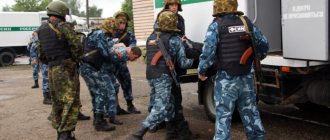Those convicted in criminal cases are subject to distribution to correctional institutions, according to the measure of responsibility applied to them.
Until the court verdict comes into force or the documents are being appealed, the convicted persons are kept in pre-trial detention center.
They cannot stay in the isolation ward all the time; it is always overcrowded. Therefore, from time to time, convicts are transported to prisons.
In criminal law, this process is called the transfer of convicts. How the transfer from the pre-trial detention center to the colony occurs, and what requirements employees of executive institutions must comply with, we will talk further.
What is a stage in prison?
Conveyance is the forced transportation of convicts in criminal cases to colonies, prisons, and camps . This stage involves the entire journey of the convicted person from leaving the pre-trial detention center to arriving at the colony.
On this path, the prisoner will experience many new experiences: from long journeys in stuffy, windowless compartments to futile attempts to transport all his property at once.
The decision to transfer a convicted person to a specific colony is made by the management of the pre-trial detention center.
But before this, the pre-trial detention center receives an order from the central department of the Federal Penitentiary Service in Moscow, which indicates which colonies and how many places there are for convicts.
Due to the fact that in many colonies they serve time only for certain types of crimes, the distribution of convicts by pre-trial detention center employees is not an easy task.
In what situations is staging required?
In a broad sense, a stage is the path of a convicted person from point A to point B. And this path is not always associated with departure to a colony.
There are other situations in which a convicted person must be transported:
- Delivery of a convicted person to court who is in a pre-trial detention center under a decision to select a preventive measure in the form of detention.
- Delivery of a convicted person to court, where a new criminal case has been filed against him, if he is already serving a sentence for another crime in a colony. It often happens that a convicted person is sitting, for example, in a prison in Tatarstan, and a new criminal case against him is received at the court site in the Chelyabinsk region. In this case, the judge issues a transfer order and sends it to another region. Sometimes you have to wait months for someone to be convicted.
- Delivery of a convicted person to court for a decision to add sentences when the convicted person is already serving time in a colony for one of the crimes committed.
- Moving convicts from one colony to another in the event of emergencies, fires or riots.
One way or another, the penal system is always associated with various movements of convicts around the country . Our country is huge, which is why convicts sometimes travel for weeks or months.
How long the stage lasts is difficult to answer unequivocally. It all depends on the distance of the colony from the pre-trial detention center.
Nizhny Novgorod - north wind
In the second half of the 19th century, railways revolutionized not only the economy and military affairs, but also the transportation of prisoners. In 1862, a railway began operating connecting Moscow and Nizhny Novgorod. And two years later the first regulation of the Ministry of Internal Affairs on the railway transportation of prisoners was issued.
For transportation, special trains of eight cars were used. Each of them accommodated up to 60 people. The payment for the transportation of prisoners was determined at 50 kopecks in silver per carriage for each mile of the journey.
Nizhny Novgorod has turned into an important transshipment point for the delivery of convict parties on a long stage route from Warsaw and St. Petersburg to Perm and Tyumen and further throughout Siberia to Irkutsk and the hard labor camps of Transbaikalia. From all the distant provinces of the Russian Empire, prisoners were transported by rail to Nizhny Novgorod.
In 1877, Emperor Alexander II approved a uniform “Regulation on the transportation of prisoners by rail” for the entire empire. During the railway stages, the prisoners were provided with “dry food”. A person was given 3 pounds (1 kg 200 grams) of bread and salt per day. On fast days, half a pound of boiled meat was allowed, and on fast days, prisoners were given boiled fish. Moreover, it was specifically forbidden to issue herring, dried, raw or salted fish.
By the beginning of the reign of Emperor Alexander III, the following order of transportation had developed. Every year during the winter, prisoners were brought from all European provinces of the Russian Empire to prisons in Moscow and Nizhny Novgorod. At that time, Nizhny Novgorod was generally a kind of prison capital - in its vicinity there were seven stone and two wooden “prison castles”, spacious by the standards of that time for transit prisons.
Since the end of April, large groups of prisoners were sent from Moscow to Nizhny Novgorod by rail on special trains. By this time, the rivers had already opened up from ice and convicts and exiles were floated on barges from Nizhny Novgorod to Perm three times every two weeks.
How to prepare for the stage?
The exact time of transfer to the convict is not reported. Before departure, the cell is visited by an employee of the detention center, who calls the name and surname of the convicted person who must serve.
It is better to start preparing for the stage immediately after the verdict comes into force.
So, recommendations for preparing for the stage are as follows:
- Pack your things and food for the trip in advance. The convicted person has the right to take with him a bag weighing up to 50 kg. The main products that you will need on the road are tea and coffee, sugar and condensed milk, and instant noodles. On commuter trains transporting convicts, only boiling water will be served.
- It is better not to take bales that are too heavy for lifting, since at the end of the route in the new colony the convict will be given a heavy mattress. At the same time, you are given only one attempt to deliver your own belongings.
- According to the stage, it is better to settle in those carriages where one of the convicts’ acquaintances is present. All convicts are transported together without division into articles. Therefore, a convict sentenced to six months in prison can travel with a dangerous repeat offender.
- It is not recommended to eat or drink a lot before the stage. This is due to the fact that opportunities to go to the toilet will be strictly limited along the way.
- It is not recommended to take large quantities of SIM cards and cigarettes with you.
- Be sure to take a first aid kit with antibiotics and anti-inflammatory drugs.
These instructions are advisory in nature. It is impossible to know for sure how the stage will go and how long the journey will take.
Procedure for transporting convicts
Sometimes convicts have to wait a long time for their turn at the prison. This is due to the fact that FSIN employees are trying to maximally staff the trains for sending convicts. No one will organize a stage for the sake of one criminal.
Before departure, a detailed search will be carried out in relation to the convict and his property.
Searches will, in principle, be carried out frequently, before and after each movement of the stage. The journey is carried out in special “carriages”. Convicts are transported to the railway in special vehicles.
Typically, convicts are taken to a transit prison, from which they are distributed to colonies. Sometimes transportation is carried out without the use of a transit prison.
At their final destination, convicts are quarantined for two weeks.
After the convict arrives in the colony, the administration is obliged to notify his relatives within 10 days.
How to find out where a convicted person is after transfer if the administration has not sent a notification?
In fact, according to the general rules, after the entry of the sentence and before the convict is sent to prison, he is granted one short-term visit with a relative.
And before sending a criminal to a correctional facility, the administration of the pre-trial detention center must also notify one relative about where the convicted person is going.
But even if none of the relatives received information about the route of the stage, they can clarify this information with a lawyer.
Prisoner "train"
From Nizhny Novgorod the stage road passed through the Nizhny Novgorod, Kazan, and Vyatka provinces to Perm. In total, from Nizhny Novgorod to Perm there were 42 transition stages; it took the prisoner parties 59 days of transportation to overcome them.
In winter, prisoners were transported in sleighs, in summer on simple carts. Conveyance stopped during the spring and autumn thaw for two weeks. Such columns of sleighs or carts were called “arrest trains.”
There were no seats or benches for prisoners; instead, rope “binders” were made, attached to the edges of the cart. Each cart carried four prisoners and one guard, sitting next to the driver.
To prevent escapes, instead of hand and leg shackles and a common chain of “Dibich rods”, when transporting by “prisoner train”, a special chain was used on the prisoner’s leg, an arshin long (about 70 cm), its end was attached to the cart with a lock. Those caught rioting, disobedient, or “attempting to escape” were chained to carts or sleighs by their hands.
The keys to the chains were handed to the non-commissioned officer in charge of the “train”. He constantly provided leadership throughout the entire route. Ordinary guards took turns at each “stage station.”
From the overnight stages, the “prisoner train” departed at 5–6 o’clock in the morning and moved throughout the daylight hours at an average speed of 8 versts per hour. According to the rules, every two hours the “train” stopped for 10 minutes.
During the transfer, the prisoners received food at the rate of 10 kopecks per day per person for the “low classes” (peasants and townspeople) and 15 kopecks for the upper classes (prisoners from the nobility, clergy and merchants). Every morning, each transported person was supposed to be given a pound (almost half a kilo) of bread and half a pound of boiled beef or fish with salt.
Tsarist bureaucrats carefully calculated that during the reign of Alexander II, the cost of moving one prisoner from Nizhny Novgorod to Tyumen cost the state 17 rubles 97 and a half kopecks.
Rules for escorting suspects and accused
Suspects, as a rule, are escorted until trial, and accused are escorted one by one. Convoying in both cases is the rules for accompanying convicts, aimed at maintaining public safety.
The escort procedure is strictly regulated. Violating the rules for escorting convicts can sometimes lead to serious consequences.
It is worth at least remembering the episode with the shooting in a Moscow court, when a girl was escorting dangerous criminals, and the number of escorts did not correspond to the number of convicts.
Who does the escorting?
Convoying prisoners in 2022 is carried out by special departments of the internal affairs bodies. For this purpose, security and escort units are created.
Their tasks include:
- Assistance in the execution of punishment by delivering convicts to colonies, prisons, and isolation wards;
- Assisting in the administration of justice by delivering convicts to the courtroom;
- Protecting public safety from criminal;
- Protecting a criminal from an indignant public.
The composition of the convoy group is as follows:
- Chief of the convoy;
- Assistant Chief;
- Dog handler;
- Escorts.
The convoy can be regular or reinforced. The latter is used in cases where the protection of dangerous criminals is necessary.
In a normal escort, there are 2 guards for 1-2 criminals. With enhanced escorting, there are 3 escorts per 1 criminal.
Escorts always have main and alternate routes. The latter are needed in cases where there is a threat of escape or attack on the car.
Escort instructions
Reception of convicts for escort is carried out one at a time in a room where only the convict and the guards are present.
The criminal is subjected to a mandatory search, and prohibited items are confiscated . The guards are required to enter all information about the convicted person into a special journal.
The search during escort is carried out by one person for every 5 convicts. There is always radio communication with the escort vehicle.
The delivery of convicted or suspects to the courts must be agreed in advance with the detention center staff . To do this, a request for the delivery of a particular person held in this institution is sent to the pre-trial detention center.
The request indicates the time and date when the court hearing will take place, the name of the judge considering his case, and is certified by a seal.
Without a properly formalized request for the delivery of a convicted person or suspect, escort will not be carried out.
In the morning, the convoy collects a group of convicts who need to be taken to the courts and transports them. Courts, as a rule, have special closed rooms, the entrance to which is set separately from the main one. It is there that the convicts are brought by a convoy vehicle.
The grounds for establishing a reinforced convoy are:
- Information about preparing for an escape;
- Information about an attack on security;
- Information about the suicide attempt of the convicted person;
- Long convoy routes;
- Geographical complexity of the convoy route;
- Carrying out convoys by air or water transport.
The convoy must be armed for security purposes . The convict is taken to the courtroom in handcuffs and taken to a cell. Once in the cell, handcuffs are removed through a special window, but not for all convicts.
At least one guard must always be present in court during the hearing.
As a rule, guards change and take turns sitting at the court hearing. Such convicts are always behind bars in the courtroom or in special glass boxes.
You can never know for sure that a convicted person or suspect is safe . There is always a risk of potential danger posed by the person being transported or escorted.
A stage is one of the stages of execution of a sentence, which consists of delivering the convicted person to the place where he will serve his assigned term. The transportation conditions are far from the best.
Convicts travel for weeks across the country in stuffy or cold carriages, without the opportunity to properly eat or wash themselves. This is one of the main tests that a convicted person must overcome at the stage of his correction.
Centuries-old Eastern Siberia
Large stages departed from Perm to Yekaterinburg twice a week. Mixed parties passed along this section - exiles on carts or sleighs, convicts on foot. When sent from Yekaterinburg to Tyumen, the prisoner parties were already split into smaller ones of 100–150 people. From Tyumen throughout Eastern Siberia and Transbaikalia, prisoners were traveling to their places of serving their sentences all year round, as it was called in bureaucratic documents - “on foot.”
In Eastern Siberia, the railway will appear only at the very end of the 19th century, so the walking stages will last a long time. Thus, on the territory of the Irkutsk province in 1881, there were 28 stages and half-stages, along which, according to centuries-old traditions, columns of prisoners were driven on foot. Irkutsk was the main transshipment base for the stage route through Eastern Siberia. Here the “shackled path” split into two - some of the prisoners were sent beyond Lake Baikal, to the Nerchinsk state-owned factories and mines, while others were transported north, to Yakutia.
Parties of prisoners brought from the west along the Siberian Highway to Irkutsk were placed in the two largest prisons in Eastern Siberia - in the Aleksandrovskaya central convict prison or in the Aleksandrovskaya transit prison, located nearby. Already in these prisons, parties of several dozen or even hundreds of people were formed, who, accompanied by a convoy, went to the place of serving their sentences. If prisoners arrived at the Alexander Central in late winter, they usually waited until the summer, and only in June, after the spring thaw, did they move on.
In Transbaikalia, before the notorious Nerchen penal servitude throughout Russia, there were another 33 stages, which the foot prisoners overcame in a month and a half of travel. Prisoners were transported across Lake Baikal itself on special ships called pauzkas. These were huge rafts on which barracks with bunks were built. Until 1886, convict parties were sent to Yakutsk on foot. Later they began to be rafted down the Lena River on the same pausk rafts.
Transportation of construction materials by exiles to buildings in Gorny Zerentui. Nerchinsk penal servitude, end of the 19th century. Photo: Alexey Kuznetsov / runivers.ru
According to the “Instructions on the reception, departure and transportation of exiles,” approved by the Governor-General of Eastern Siberia, Baron Platon Fredericks on June 13, 1876, “exiles have unmissable embroidery on both summer and winter clothes: those who are sent to hard labor have two, and those coming to the settlement - one quadrangular patch on the back, up to two inches in all directions, in a distinctive color from the clothes.” It was for such markings on the prisoners’ clothes that convicts in those days were called “tambourines” in thieves’ jargon. In addition, according to the instructions of Baron Fredericks, male prisoners sentenced to hard labor and who belonged to the lower classes before their conviction were sent to the prison camps with the right side of their heads shaved.
Each stage team was headed by an officer - in total, in the Irkutsk province at that time 686 employees, including 3 paramedics, were engaged in escorting and transporting prisoners. The salaries of soldiers and junior officers of the stage commands were very small: a sergeant major received 24 rubles, a non-commissioned officer - 18, a corporal - 2 rubles 85 kopecks, and a private received 15 kopecks less than a corporal.
Officers employed in the convoy service earned decent money at that time. During the transport of the prisoners, they were paid daily money of 1 ruble per day each, “portion and welding money,” 5 kopecks per day each “for improving food.” As a reward for good service - that is, transportation without escape - the officers of the convoy teams annually received a bonus in the amount of an annual salary.
Transporting prisoners along the Siberian Highway was a costly affair. At the end of the 19th century, moving one convict to Siberia cost an average of 125 rubles. But these are only direct expenses, and taking into account all the indirect ones - for the maintenance of “stage locks”, escort guards, etc. - this figure had already increased to 300 rubles, a very impressive amount for that time. By the beginning of the 20th century, the Main Prison Directorate of the Russian Empire spent at least a quarter of its budget on transporting prisoners to Siberia.








